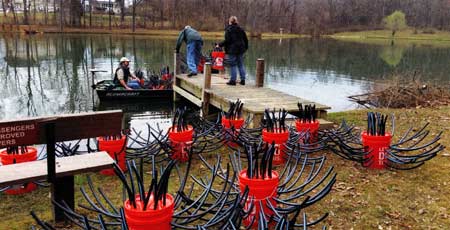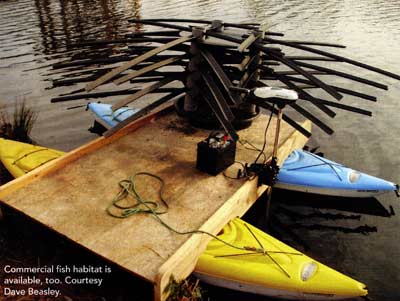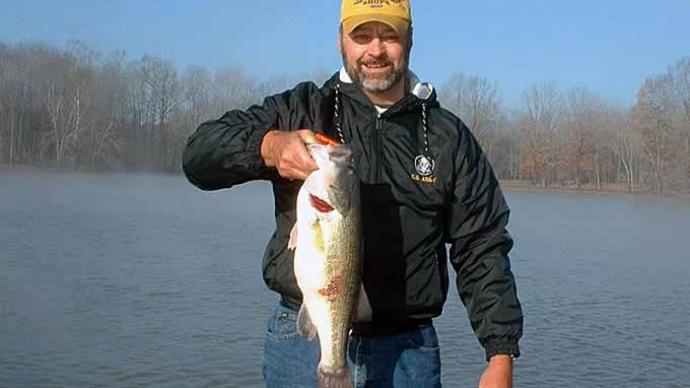
Have a northern pond? You need a checklist. Heck, this checklist is probably applicable for ponds all over.
• Fish Cover—Do you have good cover for fish under ice?
• Prepared to prevent oxygen depletion? What are the odds your pond will suffer an oxygen depletion under ice?
• Aerating northern ponds? How does aeration help frozen ponds?
• Does your fish habitat change? How does fish habitat change from summer to winter?
• Forage fish? What happens to forage fish in winter under the ice?
Right now, before ice-up, is a great time to put fish cover into your pond to set up for ice fishing. Keep in mind some of the rules of the physics of water. Water at 39-degrees is as heavy as it gets. Warmer — and colder — water expands, which means it weighs less. For you, that means your warmest water all winter under ice will be at the bottom. As long as that water is well enough oxygenated, fish will congregate deep. If you have fish cover, you can attract those fish. If you can attract fish, you can find them easier. If easier to find, they will certainly be easier to catch.
Easier to catch that is, unless your pond tends to run out of oxygen. That's a big concept in your part of the world. Winterkill is an every-winter occurrence in most areas of the north. So common that is, some people choose not to spend much money or expend much effort if that risk is too high. If your fishery has value, and you want to preserve it, invest in an oxygen/ temperature meter and monitor oxygen levels. Better yet, have an aeration system at the ready in case you need to stir things up a little bit and add some valuable air to your pond over the winter months.
What causes oxygen levels to drop to lethal limits, you might ask? Consumption, plain and simple. Fish consume oxygen, although their metabolism rates are much slower in winter than in the warm months. Plants under the ice that doesn't allow the sun's rays to penetrate stop producing oxygen and consume it. Plants can consume big volumes of oxygen, so do your best to go into winter without so many aquatic plants. Beneficial bacteria consume a big volume of oxygen as well, although most of that occurs at the pond bottom-water interface. When the totality of consumers is high enough, and water can't replenish oxygen via photosynthesis and exchange with the atmosphere, oxygen can deplete over a period of weeks.

Aeration may be a viable option. Careful, though. You don't want to cool your deepest waters and lose that thermal advantage for your fish. If you have a bottom-diffused system, you can certainly put it on a timer and run it for a few hours each day, or move the diffusers to shallower water, like 6-7 feet deep, and run it there. One big concern is forcing a hole—or preventing one—from opening through ice. That's a big safety issue. If you want a hole in the ice, bring your diffuser closer to shore so that anyone, person or animal, can escape if they fall in.
Keep in mind fish habitat will change, often dramatically. Remember, most of our fish prefer the littoral zone during the productive months, when they are spawning, foraging, and actively growing...fighting through the predator/prey relationship dynamics. Your fish, given the right amount of habitat, will thrive during those warmer months, building themselves up nutritionally and physically, as they poise to make it through winter, the harshest time of year. When the water temperatures drop, as they are right now, fish will move toward thermal cover in the deepest areas of the pond, as long as there's enough oxygen to stay alive. It's a good idea to understand their habitat needs in winter as well as in warmer seasons. Fish like to congregate, limit energy expense, move slowly because they are cold-blooded, and feed when the opportunity arises.
Speaking of eating, how are your forage fish populations going into winter? Fall is when your predator fish want to gorge themselves, add some body fat, and be in the best shape they can going into winter.
That's another reason to provide habitat in deeper water in northern ponds. You can attract baitfish into the same zone as your game fish.
One huge advantage northern pondmeisters have is the ready availability of fathead minnows at a fair price. In the north, dealers sell them by the gallon, often at prices less than $5 per pound. In the south, good biologists won't tell a pondmeister to add fathead minnows into an existing fishery. They cost too much, can't become established, and disappear fast. In the north, the cost is bearable, plus you give your fish a snack while setting them up to catch them under ice. Drill holes, pour some fathead minnows down the hole, and chum over your cover.
It works.
Another advantage?
Northern pond owners can stock a variety of species of predator fish. Smallmouth bass, walleye, tiger muskies, Largemouth bass, and a spectrum of trout species are regionally available.
How do these elements tie together?
If you go through your checklist, have safe ice with water underneath that carries good oxygen levels all winter, with good fish-attracting cover, healthy stands of forage fish with healthy game fish going into winter, your ice-fishing odds go up, especially if you keep the ice safe.
Go through this checklist, make one of your own, especially for your special waters in that part of the planet.
Reprinted with permission from Pond Boss Magazine



